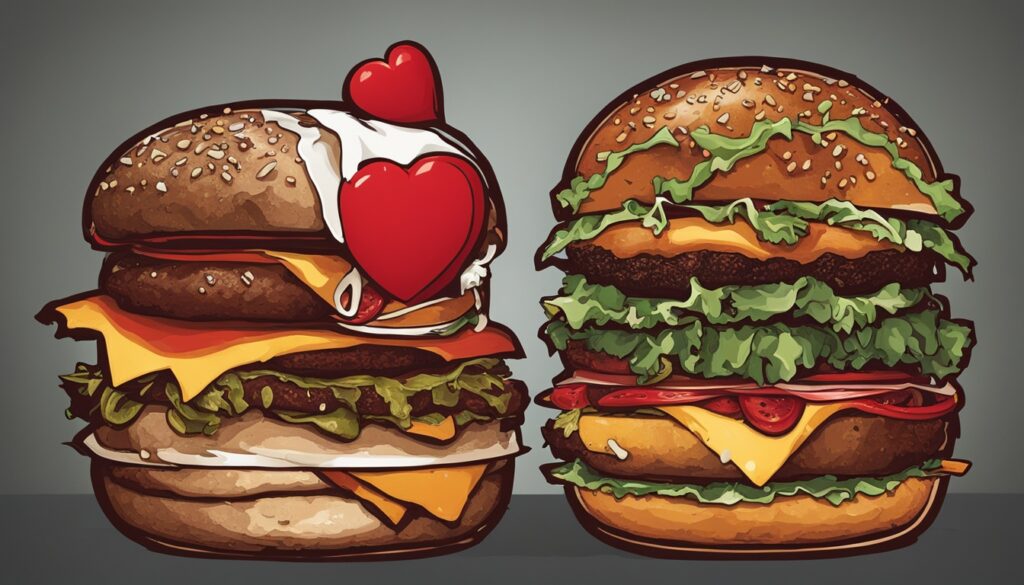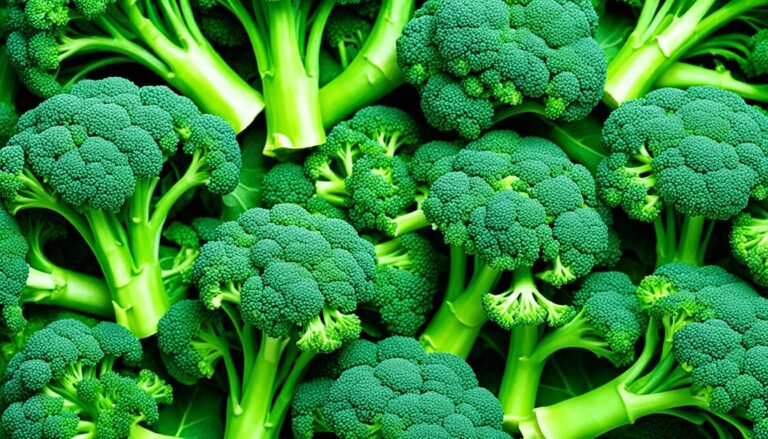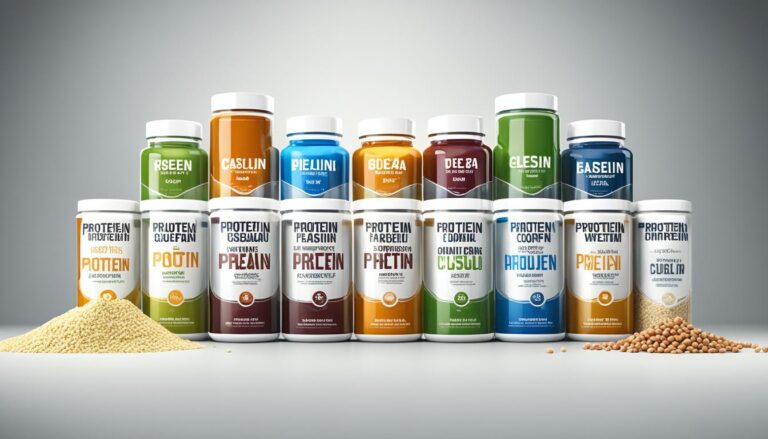Are you eating harmful fats without knowing it could harm your heart? Saturated fats are found in foods we love but are bad for our health. Let’s explore what these fats are and how they affect us. This guide will help you make better food choices1.
Key Takeaways
- Saturated fats are typically solid at room temperature and are found in animal-based foods and tropical oils.
- Consuming too much saturated fat can raise LDL (bad) cholesterol levels and increase the risk of heart disease.
- Common sources of saturated fats include pizza, cheese, full-fat dairy products, butter, and processed meats.
- The American Heart Association recommends limiting saturated fats to no more than 6% of total daily calories.
- Replacing saturated fats with healthier unsaturated fats can lower heart disease risk.
What are Saturated Fats?
Saturated fats are fats that have lots of hydrogen atoms. This makes them solid and waxy2. They are different from unsaturated fats, which are usually liquid.
These fats are mostly in animal foods like meat, dairy, and eggs. They are also in some tropical oils like coconut and palm oil2. Their unique structure makes them stand out.
Explaining the Nature of Saturated Fats
Saturated fats are called so because every carbon atom in the molecule is filled with hydrogen atoms. This straight structure makes the fat solid2. Unlike unsaturated fats, which have double bonds and are liquid.
Why Saturated Fats are Solid at Room Temperature
Their solid state comes from their chemical makeup. The straight structure lets the fat molecules pack closely, making them solid at room temperature2. This is why butter and coconut oil are solid, while olive oil is not.

“Saturated fats are primarily found in animal-based foods like meat, dairy, and eggs, as well as in some tropical oils like coconut and palm oil.”2
How Saturated Fats Affect Your Health
Saturated fats have a big effect on our health, especially on cholesterol levels and heart disease risk. Eating too much saturated fat can increase LDL (bad) cholesterol in your blood. This raises your chance of getting heart disease and having a stroke3.
The Link Between Saturated Fats and Cholesterol Levels
High LDL cholesterol can cause plaque to build up in your arteries. This can block blood flow and increase the risk of a heart attack or stroke3. The American Heart Association suggests eating less than 6% of your daily calories as saturated fat. This helps keep cholesterol levels healthy and lowers heart disease risk3.
Risks of Consuming Too Much Saturated Fat
Back in 1990, the Dietary Guidelines for Americans advised cutting down on saturated fat for heart health4. A study in 2017 showed that eating less saturated fat and more n-6 polyunsaturated fat can lower the risk of heart disease4. A 2010 study also found a link between eating more saturated fat and a higher risk of heart disease4.
It’s important to watch how much saturated fat you eat. Making smart choices can help keep you healthy and lower heart disease risk.

“The American Heart Association recommends limiting saturated fat intake to no more than 6% of total daily calories to help maintain healthy cholesterol levels and reduce the risk of heart disease.”
Top Sources of saturated fats foods
Certain foods are major sources of saturated fats in our diets. Red meat like beef, lamb, and pork, full-fat dairy products such as whole milk and cheese, butter, coconut oil, and baked goods like cakes and cookies are high in saturated fat5. These items can increase cholesterol levels and raise the risk of heart disease. So, it’s key to eat them in moderation and pick healthier options6.
A 2,000-calorie diet should have no more than 120 calories from saturated fat, which means about 13 grams a day56. But many Americans eat much more, which can be bad for their heart health.
| Food | Saturated Fat Content |
|---|---|
| Lean Beef (100g serving) | 4.5 grams5 |
| Whole Milk (1 cup serving) | 4.5 grams5 |
| Butter (1 tablespoon) | 7 grams5 |
| Coconut Oil (1 tablespoon) | 12 grams5 |
| Sundae (100g serving) | 38 grams5 |
| Brownie (100g serving) | 10.64 grams5 |
By watching what we eat and choosing wisely, we can lower our risk of heart disease. This helps us stay healthier overall6.

“Decades of sound science have shown that limiting saturated fats can reduce the risk of heart disease by lowering ‘bad’ cholesterol levels.”6
Tips for Reducing Saturated Fat Intake
Keeping a balanced diet and cutting down on saturated fats is key for a healthy heart. Start by choosing wisely when you shop for groceries. Look for foods with less saturated fat7. Also, pick leaner meats and low-fat dairy products when you can7.
Smarter Shopping Strategies
Be aware of the saturated fat in what you buy at the supermarket7. Choose items labeled as “low” saturated fat, which means 1.5g or less per 100g7. This easy step can greatly reduce your saturated fat intake.
Healthier Cooking Methods
Choose cooking methods that use less saturated fat in the kitchen. Grilling, baking, and steaming are better than frying, which adds a lot of saturated fat to your food7. Use healthy oils like olive or avocado oil instead of butter or lard8.
Making Wise Choices When Dining Out
Eating out can be tough when you want to eat less saturated fat, but you can make better choices7. Pick lean proteins like grilled chicken or fish, and go for vegetable dishes over creamy or fried ones8. Choose sauces and dressings that are low in saturated fat7.
By changing a few things in your shopping, cooking, and eating habits, you can cut down on saturated fats and help your heart health78.

| Saturated Fat Content | Guidelines | Examples |
|---|---|---|
| High | More than 5g per 100g | Butter, lard, coconut oil, full-fat dairy |
| Medium | Between 1.5g and 5g per 100g | Lean meats, poultry, eggs, some baked goods |
| Low | 1.5g or less per 100g | Fruits, vegetables, whole grains, legumes |
“Eating a diet low in saturated fat is one of the best ways to maintain healthy cholesterol levels and reduce your risk of heart disease.”8
Recommended Daily Limits for Saturated Fat
Keeping a healthy diet means watching how much saturated fat you eat. The9 Dietary Guidelines for Americans suggest adults should not have more than 10% of their daily calories from saturated fat. For someone eating 2,000 calories a day, that’s about 22 grams of saturated fat9.
Saturated fats are in meats, dairy, and some oils. They can also be added to foods like baked goods9. Foods like sandwiches, burgers, and desserts often have a lot of saturated fat9. By checking food labels and choosing wisely, you can follow these guidelines and keep your heart healthy9.
The10 UK government suggests even tighter limits. Men should eat less than 30 grams of saturated fat daily, and women less than 20 grams10. Both men and women should keep trans fat under 5 grams a day10. Following these rules can lower the risk of heart disease and other health issues from too much saturated fat9.
Incorporating moderation and balance into your diet is the key to maintaining optimal heart health and overall well-being.

Only about one-third (34%) of adults in the U.S. meet the saturated fat guidelines, eating less than 10% of daily calories from it11. Those who do, eat 236 fewer calories a day and eat less meat, cheese, and eggs11. Eating more plant-based proteins and unsaturated fats helps lower saturated fat intake and supports heart health11.
Replacing Saturated Fats with Healthier Fats
To improve heart health, swap foods high in saturated fats for those with healthier fats. This includes polyunsaturated and monounsaturated fats. Polyunsaturated fats are in fatty fish, nuts, and oils. They help lower cholesterol and reduce inflammation12. Monounsaturated fats are in avocados, olive oil, and nuts. They’re a good swap for saturated fats, keeping cholesterol healthy and supporting heart function13.
The Benefits of Polyunsaturated Fats
Polyunsaturated fats like omega-6 and omega-3fatty acids are great for health. Omega-6 fatty acids are in corn oil, soybean oil, and sunflower oil. They lower bad cholesterol and help control blood sugar12. Omega-3 fatty acids are in oily fish and flaxseed. They can lower triglyceride levels and cut the risk of heart and blood vessel diseases12.
Monounsaturated Fats: A Better Alternative
Switching to monounsaturated fats can lower bad cholesterol and triglycerides. This reduces the risk of heart and blood vessel diseases13. Avocadoes, nuts, seeds, and whole grains are good sources of healthy fats. They’re full of vitamins, nutrients, and fiber12. A healthy diet should include these foods and be low in processed foods with saturated fats13.
“Replacing saturated fats with plant-based, unsaturated fats can help improve heart health and reduce the risk of cardiovascular disease.”
| Nutrient | Recommended Daily Intake | Key Sources |
|---|---|---|
| Saturated Fats | Less than 10% of total calories14 | Meat, dairy, palm and coconut oil |
| Polyunsaturated Fats | 5-10% of total calories14 | Fatty fish, nuts, seeds, vegetable oils |
| Monounsaturated Fats | 20-30% of total calories14 | Avocado, olive oil, nuts, seeds |
By making simple swaps and following heart-healthy guidelines, you can swap saturated fats for polyunsaturated and monounsaturated fats. This supports your heart health13.
Saturated Fat and Heart Disease Risk
Eating too much saturated fat can harm your heart health15. This fat can cause cholesterol and plaque to build up in your arteries. This can block blood flow and raise your risk of heart disease and stroke15.
Research shows that eating a lot of saturated fats increases your risk of heart disease by 18%16. Switching just 1% of these fats to healthier options can lower your heart disease risk by 6%-8%16.
To stay heart-healthy, limit your saturated fat intake. Aim for no more than 10% of your daily calories from this fat, which is about 22 grams for a 2,000-calorie diet15. Choosing healthier fats can help lower your cholesterol and reduce heart disease risk15.

It’s important to read food labels and spot high-saturated fat foods like baked goods and fatty meats15. Pick lean proteins, healthy oils, and low-fat dairy to keep your saturated fat intake low and protect your heart15.
“Reducing saturated fat intake and replacing it with healthier unsaturated fats can help lower cholesterol levels and reduce the risk of heart disease.”
Reading Food Labels for Saturated Fat Content
When you’re shopping, it’s key to read food labels well to find products with less or more saturated fat. The “Saturates” or “Sat Fat” section on nutrition labels gives you the info you need to choose wisely about saturated fat in your diet17.
Understanding Nutrition Labels
Nutrition labels show how much saturated fat is in each serving. This lets you quickly see how much saturated fat a food has. Foods with less than 1.5g of saturated fat per 100g are low in saturated fat. Those with 1.5-5g per 100g are medium, and those over 5g per 100g are high17.
By picking low and medium saturated fat foods, you can cut down on this harmful fat type.
Identifying Low, Medium, and High Saturated Fat Foods
When looking at nutrition labels, check the saturated fat content per serving. For example, whole milk has 5 grams of saturated fat per serving, but skim milk has almost none17. Also, 3 ounces (85 grams) of fish has less than 1 gram of saturated fat, while the same amount of hamburger has over 5 grams17.
Choosing low and medium saturated fat foods helps you make healthier choices for your well-being.

Remember, foods with less than 0.5 grams of saturated fat per serving can be labeled as having no saturated fat17. Also, be aware of trans fats, which can raise cholesterol levels and are often found in fast food and fried items17. By reading food labels and making smart choices, you can manage your saturated fat intake and live healthier.
| Nutrition Facts | 1 Serving | 2 Servings |
|---|---|---|
| Calories | 280 | 560 |
| Saturated Fat | 4.5g (23% DV) | 9g (46% DV) |
| Sodium | 850mg (37% DV) | 1,700mg (74% DV) |
| Total Carbohydrate | 34g (12% DV) | 68g (24% DV) |
| Dietary Fiber | 4g (14% DV) | 8g (28% DV) |
| Total Sugars | 6g | 12g |
| Added Sugars | 0g | 0g |
| Protein | 15g | 30g |
| Vitamin D | 0mcg | 0mcg |
| Calcium | 320mg (25% DV) | 640mg (50% DV) |
| Iron | 1.6mg (8% DV) | 3.2mg (16% DV) |
| Potassium | 510mg (10% DV) | 1,020mg (20% DV) |
The % daily value on labels offers guidance based on a 2,000 calorie daily intake, which can be personalized with the help of a dietitian17.
Myths and Misconceptions About Saturated Fats
In the world of nutrition, the debate over saturated fats is huge. Many people still believe myths about them18. It’s important to trust experts when learning about saturated fats and heart health.
Some think saturated fats are not bad for us. But, studies show they can increase cholesterol and heart disease risk18. Eating less saturated fat and more unsaturated fats can lower heart disease risk18.
Another myth is that saturated fats only affect “bad” cholesterol. But, they actually raise both “good” and “bad” cholesterol levels18. Recent studies question if raising “good” cholesterol helps prevent heart disease18.
Leading health groups like the American Heart Association recommend eating less saturated fat for heart health18. This advice has been around since 2010. They suggest eating foods with unsaturated fats like seafood and nuts18.
The science is clear: too much saturated fat is bad for our hearts. While there’s ongoing debate, we should follow expert advice for our health.
Incorporating Moderation into Your Diet
Managing your saturated fat intake means embracing moderation, not cutting out fats completely19. It’s key to limit saturated fats but not eliminate them. Aim for a balance that includes moderate saturated fat intake and a variety of nutritious foods.
For a balanced diet, focus on getting the right mix of fats, carbs, and proteins20. Choose heart-healthy fats like monounsaturated and polyunsaturated fats to lower heart disease risk. These fats help by reducing bad LDL cholesterol and boosting good HDL cholesterol. Still, it’s okay to have some saturated fats as part of a healthy diet.
When picking saturated fat sources, make smart choices20. Go for lean protein, plant-based oils, nuts, seeds, and fatty fish over red meat, butter, and full-fat dairy. Swapping these fats for healthier options helps you eat well and keep your heart healthy.
Remember, a balanced diet with moderate saturated fat intake is about progress, not perfection19. Make slow, lasting changes to your eating habits. This way, you’ll move towards a heart-healthy lifestyle that you can keep up with over time.
Conclusion
Saturated fats can greatly affect our heart health. They might raise LDL (bad) cholesterol levels and increase the risk of heart disease and stroke21. But, the science on this topic is complex. Studies show different views on how saturated fats, heart health, and wellness are linked21.
The dietary guidelines give us a clear way to handle saturated fat intake. They suggest adults keep their intake to 5-6% of their daily calories22. By reading food labels and choosing lean proteins, we can enjoy tasty foods while keeping our hearts healthy23. Swapping saturated fats for healthier fats like those in nuts, seeds, fatty fish, and avocado is also beneficial23.
Keeping a balanced diet and making smart choices about saturated fats is key for good heart health and wellness. By staying informed and managing our diets well, we can enjoy our favorite foods. This way, we also take care of our heart’s long-term health22.





